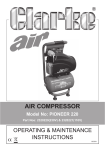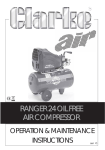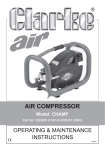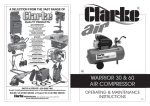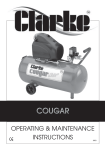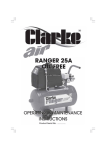Download Clarke TIGER 2500 Specifications
Transcript
TIGER 8/44 AIR COMPRESSOR OPERATION & MAINTENANCE INSTRUCTIONS 1210 1 Thank you for purchasing this AIRMASTER Air Compressor which is fitted with a 24 litre air receiver. Please read this leaflet thoroughly and carefully follow all instructions. In doing so you will ensure the safety of yourself and that of others around you, and you can look forward to the compressor giving you long and satisfactory service. GUARANTEE This product is guaranteed against faulty manufacture for a period of 12 months from the date of purchase. Please keep your receipt as proof of purchase. This guarantee is invalid if the product is found to have been abused or tampered with in any way, or not used for the purpose for which it was intended. Faulty goods should be returned to their place of purchase, no product can be returned without prior permission. This guarantee does not effect your statutory rights. SPECIFICATIONS Electrical Supply ..................................... 230 V, 1 Phase 50Hz Max. Operating Pressure ....................... 8 bar (116 lbf/in2) Motor Rating ........................................... 2 HP Air Displacement .................................... 7.8 cuft/min (185 l/m) Air Receiver ............................................. 24 litre Net Weight .............................................. 21kg Dimensions ( L x W x H ) ......................... 585 x 285 x 595 mm Duty Cycle .............................................. 20% ** Part No. .................................................... 2225325 **The machine may not be run for more than 2 minutes in any 10 minute period Please note that the details and specifications contained herein, are correct at the time of going to print. However, Machine Mart reserve the right to change specifications at any time without prior notice. Always consult the machine’s data plate When disposing of this product, ensure it is disposed of according to all local ordinances. It must not be disposed of with general household waste. 2 CONTENTS PAGE Guarantee ........................................................................................ 2 Specifications ................................................................................... 2 Contents ........................................................................................... 3 Safety Precautions ........................................................................... 4 Warning Symbols ............................................................................. 9 Electrical Connections ...................................................................... 10 Parts Identification ............................................................................ 11 Assembly .......................................................................................... 12 Preperation for use ........................................................................... 14 Operating instructions ...................................................................... 16 Routine Maintenance ....................................................................... 20 Troubleshooting ............................................................................... 22 Spare parts and services ................................................................. 23 Parts Diagram .................................................................................. 24 Parts List .......................................................................................... 25 Declaration of Conformity ................................................................. 26 3 SAFETY PRECAUTIONS WARNING As with all machinery, there are certain hazards involved with their operation and use. Exercising respect and caution will considerably lessen the risk of personal injury. However, if normal safety precautions are overlooked, or ignored, personal injury to the operator, or damage to property may result. It is in your own interest to read and pay attention to the following rules: WARNING! When using the air compressor, you should follow basic safety precautions including the following to reduce the risk of personal injury. Make sure that you have read all of the instructions before using the air compressor. Keep this booklet with the compressor for future reference by the operator. Persons who have not read this booklet should not use the air compressor. WARNING! Compressed air can be dangerous. Death or serious injury could result from improper or unsafe use of this compressor. To avoid these risks, use your common sense and follow these basic safety instructions. Compressed air should never be inhaled as it may contain toxic vapours or solid particles. Always work in good ventilation, especially when spraying paints or other toxic substances and always use a suitable face mask. Do not spray near sources of possible ignition. WARNING! Attachments, hoses and accessories must meet or exceed the maximum pressure rating of this compressor. If low pressure parts are used, the air pressure could cause them to explode or fly apart, resulting in serious injury. Always take great care when releasing the pressure and connecting/disconnecting tools. WARNING! This compressor must be connected to a power socket that is safeguarded by a suitable circuit breaker or fuse. 4 SAFETY PRECAUTIONS TRAINING: Prior to use all operators should become familiar with the instructions in this booklet. In particular, become familiar with the ON/OFF control for emergency stopping. ALWAYS WEAR EYE PROTECTION: When operating the air compressor, always wear eye protection, and make sure that other people in the work area are also wearing eye protection. Eye protectors must provide protection from flying particles both from the front and from the side. NEVER TOUCH MOVING PARTS: Never place your hand near any moving parts on the air compressor or operate with the covers removed. PROTECT YOUR SELF AGAINST ELECTRIC SHOCK: Never operate the air compressor in wet or damp locations. DRESS PROPERLY: Do not wear loose clothing or jewellery as they may be caught in moving parts. Tie long hair out of the way. KEEP VISITORS/CHILDREN AWAY: Do not allow visitors/children to handle the air compressor or attachments and ensure that any people in the work area are suitably dressed. KEEP THE WORK AREA CLEAN: Cluttered areas invite accidents, clear the work area of all unnecessary tools, debris and furniture. DISCONNECT THE AIR COMPRESSOR: Always disconnect the air compressor from the mains power supply and decompress before performing maintenance, changing any parts and when not in use. DO NOT ABUSE THE CABLE: Never pull on the cable when removing the plug from the mains socket, or lift the compressor by the mains cable. BREATHING QUALITY AIR: This compressor should not be used to supply breathing quality air. DO NOT ABUSE THE COMPRESSOR: Do not stand on the compressor. SAFETY VALVE: Never remove or attempt to adjust the safety valve. Keep the safety valve free from paint and other accumulations. AVOID UNINTENTIONAL STARTING: Do not move the air compressor when it is connected to the mains power supply. When connecting the air compressor to the mains supply make sure the red button on top of the air compressor is in the OFF (down) position. 5 SAFETY PRECAUTIONS STORE THE AIR COMPRESSOR PROPERLY: When not in use the air compressor should be stored in a secure, dry place out of the reach of children. Always lock up the storage area. PROTECT YOUR HEARING: Ear protection should be worn when operating this compressor. MAINTAIN THE AIR COMPRESSOR WITH CARE: If the air compressor is damaged in any way, have it repaired by a qualified service engineer. EXTENSION LEAD: Only use extension leads that are of an appropriate power rating and suitable for the work environment. Extension leads must have an earth connection. Inspect the extension lead regularly and replace if damaged. ONLY USE PARTS AND ACCESSORIES RECOMMENDED IN THIS MANUAL: The use of unauthorised accessories or attachments is not permitted and may result in personal injury and damage to the air compressor. Do not attempt to repair or modify the air compressor. STAY ALERT: Watch what you are doing, use common sense, and do not operate the air compressor when you are tired. The air compressor should not be used if you are under the influence of alcohol, drugs or any medication that makes you drowsy. BEFORE EACH USE CHECK THE AIR COMPRESSOR AND HOSE FOR DAMAGED PARTS: Never use the air compressor if it has been damaged in any way. Have the air compressor repaired by a qualified service engineer. Do not use the air compressor if the On/Off switch does not operate correctly. HANDLE THE AIR COMPRESSOR CAREFULLY: Operate the air compressor according to the instructions contained within this instruction booklet. This air compressor should never be operated by children or individuals unfamiliar with its operation. KEEP THE MOTOR AIR VENT CLEAR: Keep the motor vent clear and free from dust, wipe regularly to maintain an adequate supply of clean air to the air compressor. OPERATE THE AIR COMPRESSOR AT THE CORRECT VOLTAGE: Make sure that the mains supply voltage is the same as the voltage shown on the rating plate. DO NOT WIPE THE PLASTIC PARTS WITH SOLVENT: Do not use solvents or thinners such as petrol, benzene, carbon tetrachloride or alcohol to clean the air compressor, as these chemicals will damage the finish. With the air compressor unplugged from the supply, use a dry cloth to wipe over the plastic casing. 6 SAFETY PRECAUTIONS KEEP ALL SCREWS AND COVERS TIGHTLY IN PLACE: Check the screws and covers periodically. ADEQUATE VENTILATION: The compressor should only be used in areas with adequate ventilation and should not be exposed to heat, or used near inflammable substances. NEVER USE AN AIR COMPRESSOR WHICH APPEARS DEFECTIVE OR IS OPERATING ABNORMALLY: If the compressor operates unusually or makes strange noises, switch off immediately and purge the air tank. Arrange repair with an authorised service centre. DO NOT MODIFY THE AIR COMPRESSOR: Do not attempt to modify the air compressor, tank, fittings or attachments in any way. Doing so will invalidate the guarantee and could result in personal injury. DO NOT MODIFY THE TANK: Do not modify the tank or operate at pressures or temperatures outside the limits stated in this booklet. TURN OFF THE AIR COMPRESSOR WHEN NOT IN USE: When not in use, turn off the air compressor by pressing the On/Off switch, remove the plug from the mains supply and slowly undo the drain valve to release the pressure from the tank. Remember to close the drain valve before storage and ensure it is fully tightened before use. DO NOT TOUCH HOT SURFACES: During operation, the motor, connections, compressor body, cylinder head and tubes may get hot, please take care. DO NOT DIRECT THE AIR STREAM AT THE BODY: Do not direct the air stream at people or animals, as injury may result. Compressed air can cause soft tissue damage and propel dirt and other particles at high speed. ONLY USE RECOMMENDED PARTS: To avoid the risk of bursting, only hoses with a rated pressure of 8 bar, or more should be used. Never attempt to repair faulty hoses. DO NOT USE THIS COMPRESSOR TO INFLATE SMALL, LOW-PRESSURE OBJECTS: Items such as children's toys or footballs can explode if over-inflated. AVOID KINKING OR TRAPPING THE AIR HOSE: Always replace faulty hoses - never attempt a repair if a leak is detected. DRAIN TANK: Drain the tank after each use. Switch off and sowly open the drain valve to release the air then tilt the compressor to empty condensed water. 7 SAFETY PRECAUTIONS NEVER STOP THE COMPRESSOR BY REMOVING THE PLUG OR SWITCHING OFF AT THE MAINS SUPPLY: Always use the On/Off switch on the compressor. NEVER OPERATE WITHOUT ALL GUARDS IN PLACE: Never operate without all guards or safety features in place and in proper working order. NEVER OPERATE IN THE PRESENCE OF FLAMMABLE LIQUIDS OR GASES: The air compressor produces sparks during operation. CHECK FOR DAMAGED PARTS AND AIR LEAKS: If any part of the compressor is damaged, it should be carefully checked to determine that it will operate correctly and perform its intended function. Check for the alignment of parts, damage to parts, air leaks and any other conditions that may affect its operation. A guard or any other part that is damaged or defective should be properly repaired or replaced by an authorised service centre. Defective pressure switches must be replaced prior to further use of the compressor. ONLY USE WITHIN THE RECOMMENDED OPERATING TEMPERATURE RANGE: This compressor should only be used in an ambient temperature of between 0OC and 25OC. CLEANING AND CONDITION OF THE COMPRESSOR: Keep the external surfaces of the tank clean. Avoid impact damage and do not allow the tank to come into contact with abrasive or corrosive materials. MOVING THE COMPRESSOR: Always transport the compressor by lifting or pulling it with the appropriate grips or handles. USING THE COMPRESSOR FOR PAINTING: • Do not work in enclosed areas or near naked flames. • Make sure that the area in which you are working has good ventilation. • Protect your nose and mouth with a suitable face mask. • Always check the safety data sheets for substances being sprayed & ensure manufacturers instructions are followed. MOTOR HOUSING: Do not insert your fingers or other objects inside the motor housing to avoid physical damage or damage to the compressor. 8 WARNING SYMBOLS READ THIS INSTRUCTION BOOKLET CAREFULLY BEFORE POSITIONING, OPERATING OR ADJUSTING THE COMPRESSOR. Risk of electric shock. The compressor must be disconnected from the mains supply before removing any covers. Do not use in a damp environment. Risk of accidental start-up. The compressor could start automatically in the event of a power cut and subsequent reset. Do not carry the compressor while it is connected to the power source, or when the tank is filled with compressed air. This compressor contains surfaces which may reach a high temperature during operation. Never operate with the motor housing removed. Air and condensation water can burst from the compressor when the drain plug is removed. Wear a safety goggles and ear protectors when using this compressor This compressor produces a high sound level during operation. Ear protection should be worn. 9 ELECTRICAL CONNECTIONS Connect the mains lead to a standard, 230 Volt (50Hz) electrical supply through an approved 13 amp BS 1363 plug, or a suitably fused isolator switch. WARNING! THIS APPLIANCE MUST BE EARTHED IMPORTANT: The wires in the mains lead are coloured in accordance with the following code: Green & Yellow Blue Brown - Earth Neutral Live As the colours of the flexible lead of this appliance may not correspond with the coloured markings identifying terminals in your plug proceed as follows: • Connect GREEN & YELLOW cord to terminal marked with a letter “E” or Earth symbol “ ” or coloured GREEN or GREEN & YELLOW. • Connect BROWN cord to terminal marked with a letter “L” or coloured RED. • Connect BLUE cord to terminal marked with a letter “N” or coloured BLACK. If this appliance is fitted with a plug which is moulded onto the electric cable (i.e. non-rewireable) please note: 1. The plug must be thrown away if it is cut from the electric cable. There is a danger of electric shock if it is subsequently inserted into a socket outlet. 2. Never use the plug without the fuse cover fitted. 3. When replacing a detachable fuse carrier, ensure the correct replacement is used (as indicated by marking or colour code). 4. Replacement fuse covers can be obtained from your local dealer or most electrical stockists. FUSE RATING The fuse in the plug must be replaced with one of the same rating (13 amps) and this replacement must be ASTA approved to BS1362. We strongly recommend that this machine is connected to the mains supply via a Residual Current Device (RCD) If in any doubt, consult a qualified electrician. DO NOT attempt any repairs yourself. 10 PARTS IDENTIFICATION 2 4 5 3 15 1 6 13 7 14 16 10 12 11 9 8 1 Motor housing 9 2 On/Off switch (red button) 10 Compressed air reservoir 3 Main reservoir pressure gauge 11 Transportation wheel 4 Output pressure regulator 12 Data plate 5 Regulator locking ring 13 Pressure regulator and cut-out 6 Output pressure gauge 14 Oil dipstick 7 Handle 15 Outlet tap 8 Support foot 16 Oil drain bolt 11 Drain valve ASSEMBLY WARNING! Before assembling and using the air compressor, make sure that you have read and understood all of the safety instructions. Installation Take care when lifting the compressor from the packaging. CAUTION! Do not lift the compressor by the pressure regulator and cut-out. Get assistance if necessary. This unit weighs 21 kg. After removing the compressor from its packaging, check the integrity of the unit, making sure it has not been damaged in transit. Fitting the transportation wheels Fit the transportation wheels to either side of the compressor as shown in figures 1 & 2 using a 17mm spanner. Bolt Washer Wheel Nut Spring washer Figure 2 Figure 1 Fitting the rubber foot Push the rubber foot into place as shown in figure 3. Figure 3 12 ASSEMBLY Locating the air compressor This compressor should be positioned on a stable, flat surface (or one with a maximum inclination of 15O), See figure 4, and ensure it is completely stable. Do not cover or box in the compressor. Always position it at least 50cm from any obstacle or wall 150 Make sure the compressor has good all round ventilation. max 1234567890123456789012 1234567890123456789012 1234567890123456789012 1234567890123456789012 Figure 4 Moving the air compressor Before moving the compressor, switch off and disconnect it from the mains power supply. • Always use the handle. • Do not lift by (or put strain on) fittings, valves or hoses. • Take care when moving the compressor to avoid damaging the valves or fittings. The compressor is heavy, get assistance when lifting and moving this compressor to avoid injury. 13 PREPARING FOR USE Before connecting your compressor to the mains supply, check the following:• The mains voltage is 230V. • The ON/OFF switch (2) is in the OFF (lower) position. • The pressure regulator (5) should be set at its lowest setting, i.e. turned fully anticlockwise. • If the machine has not been used for 24 hours or so, open the drain valve (9) to drain any condensate which may have accumulated. When clear, close the valve, finger tight. IMPORTANT: If the receiver is under pressure, keep your hands well away from the air being expelled.... remember, compressed air is DANGEROUS! WARNING! Before connecting any air tool, make sure you have read and fully understood the manufacturers instruction booklet for the tool being used. Also ensure that the tool is compatible with the compressor and hose specifications. If the pressure rating of the tool is less than 8 bar, the pressure regulator must be used to adjust the output pressure. 1 Attach the air hose to the air outlet tap using the hose nut. See figure 5. Hose nut • Ensure that the drain valve is finger tight. For the location of the drain valve, see page 11. 2 Finally, plug the mains cable into the supply socket and switch on the power. Figure 5 On/Off Switch Figure 6 14 PREPARING FOR USE Before connecting your compressor to the mains supply, Check the Oil 1. Lift the dipstick out of the oil reservoir. Figure 7 2. Ensure the oil level is between the min and max marks on the dipstick. • If needed top up the reservoir using suitable oil, taking care not to exceed the maximum mark. Figure 8 15 OPERATING INSTRUCTIONS Switching the air compressor ON The compressor will make a continuous loud noise when the tank is charging this is normal. 1 Lift the red On/Off switch located on top of the air compressor to switch the compressor ON. • The compressor will then charge the main tank to 8 bar (116 psi). When this pressure is reached, the compressor will switch itself off. • The compressor will restart automatically whenever the pressure in the main tank falls below around 6 bar (87 psi). 2 Figure 10 Figure 9 Check the operation of the safety valve, under pressure, daily by pulling the ring as shown in figure 9. Air should be released you pull the ring and stop when the ring is released. • If the valve does not operate as described, or if the valve is stuck, it must be replaced by qualified service personnel before using the compressor. WARNING! Do not remove or attempt to adjust the safety valve. 3 Loosen the locking ring and select the pressure you need using the pressure regulator. 4 Tighten the locking ring by holding the pressure regulator firmly in place and rotating the locking ring anticlockwise until it tightens against the underside of the pressure regulator. See figure 10. Pressure regulator Locking ring Output pressure gauge Figure 10 16 OPERATING INSTRUCTIONS 5 The illustration below shows the pressure regulator locked at 6 bar. • Never set the pressure higher than the rated pressure of the attachments being used, as there is a risk of bursting and resultant injury. To increase the output pressure from this preset value you will need to intentionally loosen the locking ring. • Only alter this setting if you are using an air tool with a higher pressure requirement. 6 Open the outlet tap. Pressure regulator Regulator locking ring locked at desired pressure. Main reservoir pressure gauge Outlet tap Output pressure gauge Figure 11 17 OPERATING INSTRUCTIONS Switching the air compressor off To switch the air compressor off, 1. Close the outlet tap and press down the on/off switch (red button) located on top of the air compressor. 2. Switch off the mains supply and remove the plug. • You should never leave the compressor air tank unattended while under pressure, as this may result in an accident. • Always release the pressure from the tank when not in use or prior to storage, as described in 'Draining the reservoir' on page 19. Removing a tool from the air hose WARNING! Always set the pressure regulator to zero before attempting to remove or replace a tool. 1 Press down the on/off switch (red button) located on top of the pressure regulator. 2 Close the air outlet tap and trigger the equipment (spraygun, air tool etc), to release air from the air hose BEFORE disconnecting the hose from the machine. Reset button This compressor is equipped with a themal overload device, which operates as a safety device to protect the motor. When the motor overheats for any reason, the overload cutout automatically cuts the power thereby preventing damage to the motor. Wait around 5 minutes for the motor to cool and press the reset button. If you restart the compressor and the overload cutout activates again, switch Figure 12 off the compressor, remove the plug from the mains and have your compressor checked by a qualified service agent. 18 OPERATING INSTRUCTIONS Draining the reservoir Caution! It is important to drain the reservoir before storage. 1 Switch the air compressor off, by pressing down the red on/off button, and remove the plug from the mains supply. • Place a suitable container beneath the compressor to catch any condensate. 2 Carefully undo the drain valve anti-clockwise until you hear a hissing noise, this is the reservoir depressurising. • When the gauge indicates zero and the hissing has stopped, tighten the drain outlet nut again. Drain valve Figure 13 19 ROUTINE MAINTENANCE IMPORTANT: Before carrying out any maintenance, always disconnect the compressor from the mains supply, drain the air receiver and, if necessary, allow the machine to cool down before starting work. Daily Check Oil Ensure the oil level is between the min and max marks on the dipstick. See page 14 and top-up if necessary - (use Clarke SAE40 compressor oil, available from your local dealer). Drain the tank After use, always open the drain valve to ensure that any liquid that may have condensed, is drained off. See page 19. Monthly The air intake filter should be inspected on a MONTHLY basis, and more often in dusty conditions, To clean the air intake filter, 1. Remove the sponge element shown in fig. 14. 2. Clean the sponge and the inner housing using a soft brush. • If necessary, the sponge filter may be gently washed in warm soapy water, 3. Rinse and allow the filter to dry thoroughly before refitting. 20 Figure 14 ROUTINE MAINTENANCE Every six months Make sure that all bolts are securely tightened. Clean all the external parts of the compressor. Oil After the first 100 hours use, replace the oil completely using Clarke SAE40 compressor oil. Then replace the oil after every 500 hours of operation or every 6 months. To empty the oil from the machine, remove the oil drain plug from the crankcase cover. Figure 15 Non Return Valve Examine the non-return valve, and replace the gasket and valve if necessary Figure 16 21 TROUBLE SHOOTING With considerate use, your AIRMASTER Air Compressor should provide you with long and trouble free service. Routine checks should be made on both the electrical supply as well as on all the compressed air lines and connections. If any fault appears, the reason for which is not immediately obvious, we recommend that you contact Machine Mart. Fault Cause Remedy Bad connections. The compressor stopped and does not start. Check electrical connections. Clean and tighten as necessary. Overload cutout switch has tripped or duty cycle has been exceeded. Switch off and wait approx 5 minutes before pressing the reset button and switching on again. Motor windings burnt out. Contact Machine Mart for a replacement motor. The compressor does not reach the set pressure and overheats easily. Compressor head gasket blown or valve broken. Wait for compressor to cool down, disassemble head and replace any broken components. Carefully clean all sealing sur faces before reassembling. If in doubt contact Machine Mart. Compressor does not start. Air receiver charged Open drain valve to expel air. Compressor should start again when pressure reduces. Faulty non-return valve. Air leaking from the pressure switch valve when the compressor is not running. First drain receiver completely of air. Remove the valve end plug, carefully clean the valve seat and the gasket and reassemble. Air pressure from the regulator will not adjust. The diaphragm within the regulator body is broken. Replace regulator The compressor is very noisy and makes a metallic knocking sound. Compressor damaged and needs overhaul. Return the machine to your nearest service agent. CAUTION Do not attempt any repair or adjustment if you are uncertain as to how it should be done. If you have any queries, contact Machine Mart. 22 SPARE PARTS AND SERVICE For spare parts and service, please contact your nearest dealer, or Machine Mart, on one of the following numbers. PARTS TEL: ............................... 0115 956 1805 SERVICE TEL:........................... 0115 956 1809 CUSTOMER CARE LINE: ......... 0115 956 1810 OR: ......................................... 0115 955 9999 23 PARTS DIAGRAM 24 PARTS LIST NO. DESCRIPTION 1 2 3 4 5 6 7 8 9 10 11 12 13 14 15 16 17 18 19 20 21 22 23 24 25 26 27 28 29 30 31 32 33 34 35 36 37 38 SCREW M6X10 O-RING SCREW OIL DIPSTICK CASING COVER CASING COVER GASKET CRANKSHAFT CASING CON. ROD PIN RETAINING RING GUDGEON PIN PISTON PISTON RING SET COMPLEAT PISTON O-RING 3212 NBR CYLINDER CYLINDER GASKET VALVE PLATE HEAD GASKET SCREW HEAD SCREW OVERLOAD CUTOUT NUT CAPACITOR BEARING SEAL RING ROTOR WOUND STATOR BEARING REAR COVER SCREW FAN CIRCLIP HOUSING FILTERING ELEMENT O-RING 117 SET OF GASKETS NO. DESCRIPTION PART NO. 50 51 52 53 54 55 56 57 58 59 60 61 62 63 64 65 66 67 68 69 70 71 72 73 74 75 76 77 FN014013024 FN010072000 FN130203179 FN012043000 FN016120003 FN116120030 FN116120004 FN116120006 FN116091021 FN015001000 FN116022040 FN116022004 FN216022002 FN416022004 FN010133000 FN116HT0001 FN116HT0002 FN116120100 FN116120014 FN014013031 FN116120015 FN014001071 FN008262000 FN014003018 FN009200004 FN033082000 FN010132000 FN116HT0004 FN155812077 FN033005000 FN116120007 FN161173025 FN116120008 FN015083000 FN116120001 FN116120017 FN010024000 FN216120004 78 79 80 81 25 PART NO. TANK FN168HQ1000 TAPPING SCREW FN014013042 WASHER FN014005006 WHEEL SPINDLE FN168HQ0004 WHEEL FN020188000 NUT FN014003005 DRAIN VALVE FN022021000 VIBRATION DAMPER FN020146000 PUMP SF2500 FN516HQ21604 KNOB FN020147000 RILSAN TUBE FN046001000 SMALL PRESSURE GUAGE FN330006000 QUICK COUPLER NIPPLE FN011731000 QUICK COUPLER FN322053000 PRESSURE REDUCER FN319117000 NIPPLE FN011017000 POWER CABLE FN164A04600 PRESSURE SWITCH FN321053000 SAFETY VALVE FN047022000 LARGE PRESSURE GUAGE FN330004000 NIPPLE FN199110140 VIBRATION DAMPER FN199575000 CHECK VALVE FN347043000 O-RING FN010041000 TAPERED SPRING FN047113002 SEAL FN047113001 COMPASS FN011304000 DELIVERY PIPE ALUMINIUM FN168HQ0003 L JOINT FN011117001 COMPRESSION RING FN011117000 LOCKNUT FN011117002 LOCKNUT FN199437000 26 27 28




























